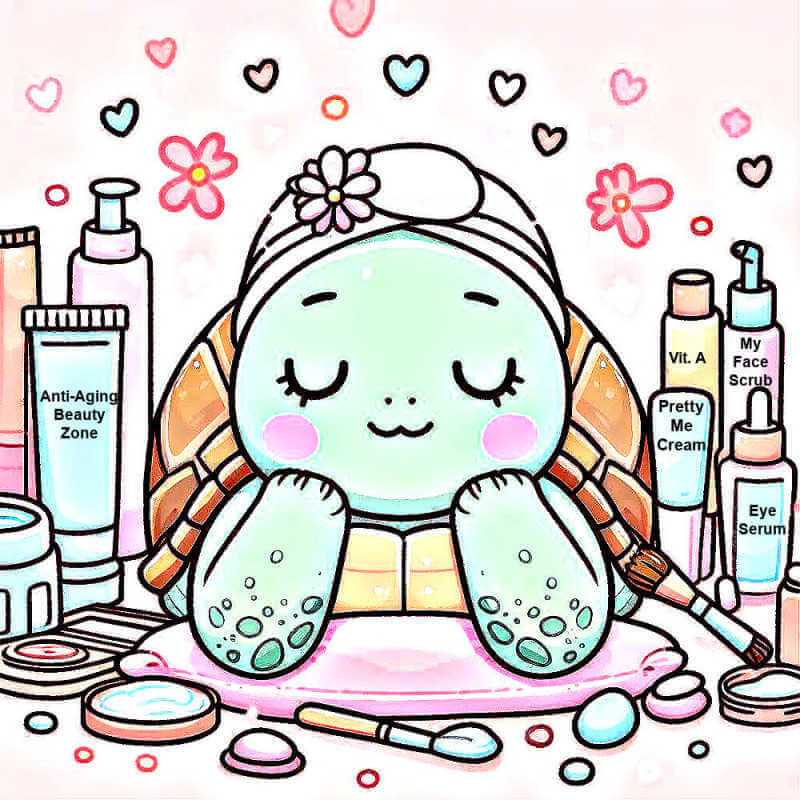As an Amazon Associate, I earn from qualifying purchases and other affiliate links. I only recommend products I’ve tried or researched.
- Home
- Skin Nourishing Foods
Skin-Nourishing Foods: Smart, Everyday Choices for Healthy, Glowing Skin
by: Linda Robison / Facial Fitness Specialist
I’ve worked in the health and wellness space for years—including my time as a health advisor at the Life Extension Foundation—and one thing I’ve learned is this: your daily food choices can influence how your skin looks, feels, and ages.
The good news? You don’t need pricey products or complicated routines. Just real, skin-nourishing foods you can grab at any grocery store.
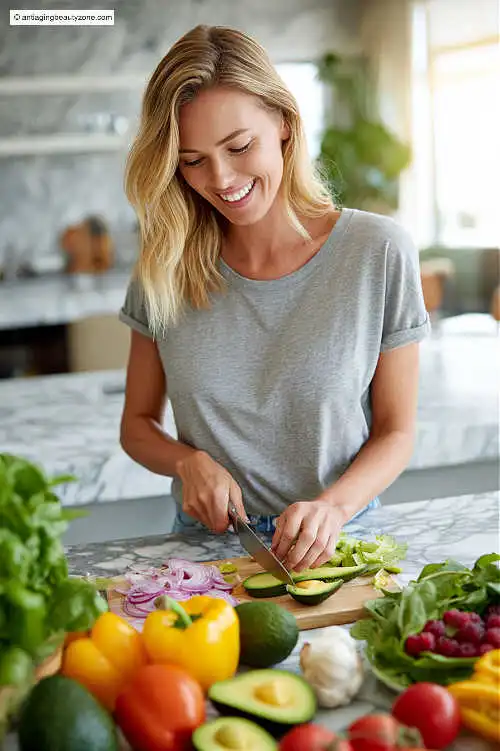 You don’t need pricey products—just real food like this that you can grab at any grocery store.
You don’t need pricey products—just real food like this that you can grab at any grocery store.There’s a lot of hype out there, but some nutrients really are proven to help your skin stay strong, smooth, and healthy as you age.
In this guide, I’ll walk you through the ones I rely on—and how to easily work them into your everyday meals.
How food affects your skin as you age
As we get older, skin naturally changes. Collagen production slows down, the skin barrier weakens, and our ability to repair environmental damage becomes less efficient. But that doesn’t mean you’re powerless.
Your daily food choices can play a big role in how your skin responds to aging.
Certain nutrients can:
- Support collagen production and reduce sagging
- Help fight oxidative stress from UV exposure and pollution
- Keep skin cells hydrated by strengthening the skin barrier
- Calm inflammation—a major driver of dullness, puffiness, and uneven texture
These effects may not happen overnight, but when you give your skin the nutrients it needs consistently, you’re building long-term support from the inside out.
Of course, topical care and high-quality supplements can absolutely help too—but your skin still needs a solid foundation from food. It’s one of the simplest (and most affordable) places to start.
What nutrients help your skin look healthier as you age?
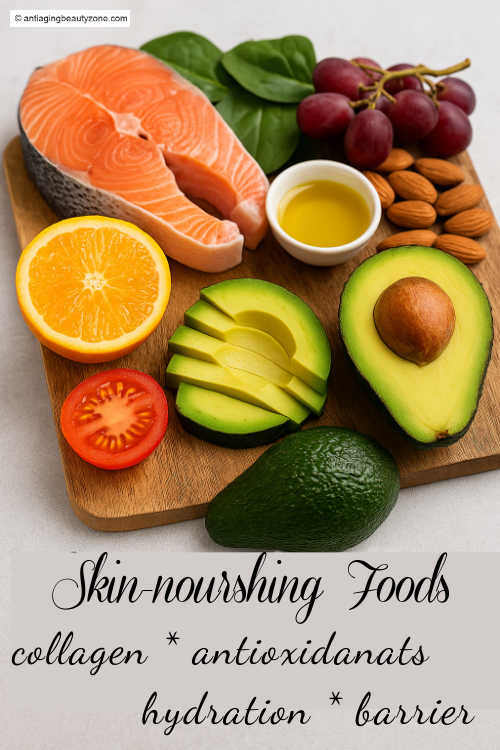
These are the key nutrients that help skin stay firmer, brighter, and more resilient over time.
Want a deeper dive into skin-aging nutrients? Explore these powerful foods that help fight signs of aging from the inside out.
They’re easy to find, simple to prepare, and can make a real difference when included regularly. Each one supports skin in a different way:
- Collagen → Keeps skin firm and bouncy
- Antioxidants → Help defend against sun damage and pollution
- Hydration → Smooths and plumps for a healthy glow
- Skin barrier → Locks in moisture and protects from irritation
Small things—but they add up.
Sulfur-rich foods (like garlic, onions, and leeks)
Sulfur helps your body produce collagen and keratin—two key proteins that give skin its structure and strength. It also plays a role in detoxification and reducing skin flareups.
I grew up eating garlic and onions in everything, thanks to my Polish grandmother. Back then I didn’t know why she used them—I just liked the flavor.
Now I understand why her skin looked so smooth in her 80s.These veggies are low-cost and powerful.
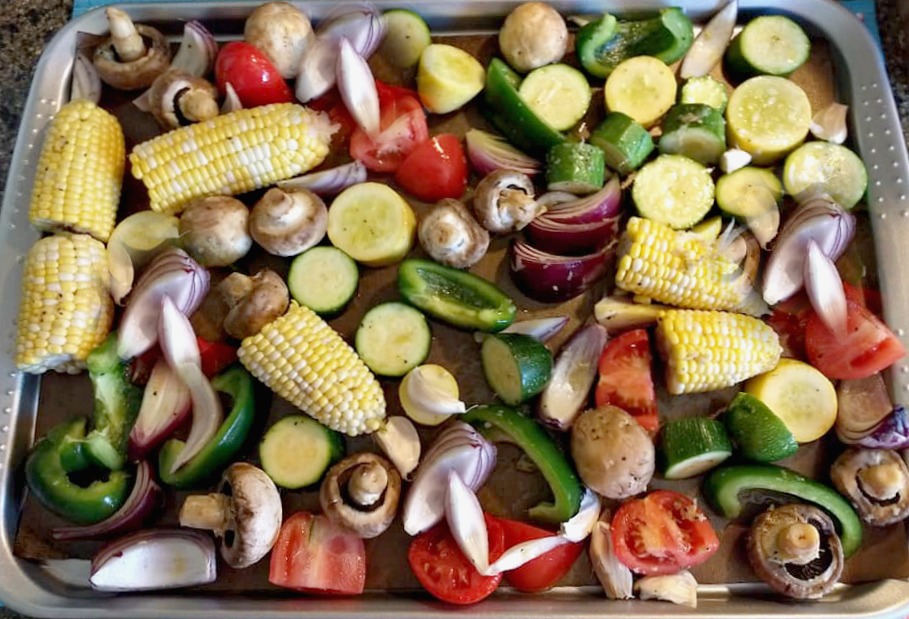 My real-life go-to: I roast a big batch of veggies like these once a week. It’s one of the easiest ways to eat more skin-nourishing foods—without having to think about it every day.
My real-life go-to: I roast a big batch of veggies like these once a week. It’s one of the easiest ways to eat more skin-nourishing foods—without having to think about it every day.ABZ Tip: It’s surprisingly easy to get enough of these sulfur-rich foods—just sneak chopped onions or garlic into soups, stews, salads, stir-fries, or roast them with veggies. Once you get in the habit, it really starts to feel second nature.
Vitamin C (citrus, berries, and peppers)
Vitamin C is one of the most skin-friendly nutrients out there.
It helps build and maintain collagen, supports skin healing, and protects against free radical damage from things like sun exposure and pollution.
It can even help reduce dullness and rough texture over time.
You don’t need mega doses or expensive routines to see benefits—just getting enough vitamin C in your meals (and using it topically) can go a long way for your skin.
Citrus fruits are the obvious choice, but so are bell peppers (especially yellow and red), raw kale, and broccoli—to name a few.
ABZ Tip: I usually add red or yellow bell peppers to salads or quick stir-fries, and toss berries into yogurt or oatmeal. Just one or two of these a day can help your skin stay smoother, brighter, and more hydrated.
Phytochemicals (kale, carrots, spinach, tomatoes)
Phytochemicals are plant compounds that help protect your skin against environmental stressors—like UV rays and pollution.
They calm inflammation and slow collagen breakdown, which helps skin stay firmer, smoother, and more even-toned.
There are thousands of phytochemicals in food, but you don’t need to know them all. The shortcut? Eat more color.
The deeper and brighter the food, the more skin-protective nutrients it likely has.
ABZ Tip: I keep frozen spinach on hand and throw it into soups, pasta, or blend into skin clearing smoothies. No need to overthink it—kale chips or roasted carrots are great add-ins too.
Lycopene & carotenoids (tomato paste, carrots, sweet potatoes)
Carotenoids are what give fruits and vegetables their orange, red, and yellow colors—and they’re great for your skin.
Lycopene, found in tomatoes, has been studied for its ability to help protect your skin from UV damage and support collagen structure.
Cooking makes lycopene easier for your body to absorb, which is why tomato paste is one of the most underrated anti-aging foods.
ABZ Tip: I always keep tomato paste on hand and sneak a spoonful into sauces, soups, stews and veggie dishes. It adds a rich, savory, umami flavor—and a real boost for your skin.
Astaxanthin & omega-3s (salmon, shrimp, and eggs)
Astaxanthin is a red-orange pigment found in seafood like salmon and shrimp—and it’s one of the most powerful antioxidants studied for skin health.
It helps reduce fine lines, improve elasticity, and protect your skin from UV damage and oxidative stress.
Omega-3 fatty acids, also found in fatty fish and eggs, help hydrate the skin and strengthen the skin barrier. They’re especially helpful if your skin tends to feel dry, irritated, or flaky.
I don’t eat seafood every day, so I rely on chia seeds and supplements for this one.
ABZ Tip: Try making a batch of salmon patties, shrimp stir-fry, or a frittata with omega-3–rich eggs. Even just one or two seafood meals a week can help support your skin from the inside out.
Vitamin E & healthy fats (avocado, olive oil, and nuts)
Vitamin E is a powerful antioxidant that helps protect skin cells and lock in moisture—especially important as skin gets drier with age or hormonal changes.
Healthy fats also support smooth, soft, more resilient skin. And the best part? They're easy (and tasty) to add to everyday meals.
ABZ Tip: Drizzle olive oil over veggies, toss avocado on toast or salads, or grab a handful of almonds. Simple, skin-loving upgrades that actually taste good.
Polyphenols & EGCG (green tea, black tea, and grapes)
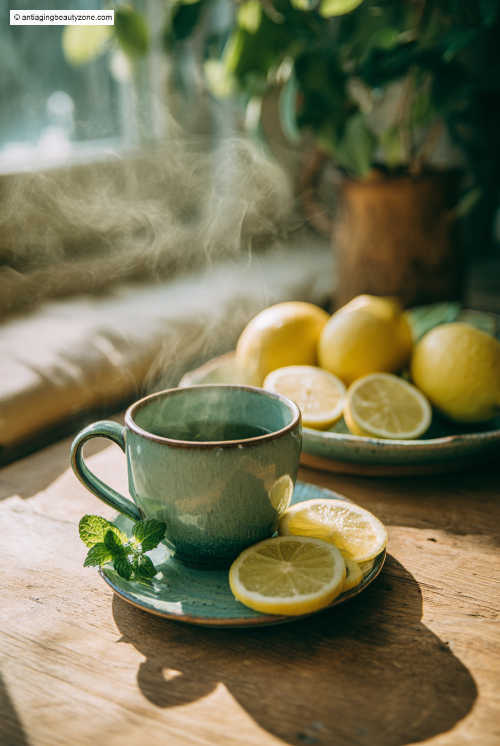
Polyphenols are plant compounds that protect your skin from premature aging (especially the ones found in herbal teas like rooibos and chamomile) caused by inflammation, stress, and pollution.
One standout is EGCG, a powerful antioxidant in green tea that’s been studied for reducing puffiness, evening skin tone, and even offering mild firming benefits—especially with regular use in your diet or skincare routine as a facial cleanser.
And here’s a fun bonus: Green and black tea naturally contain caffeine, which may help reduce the look of puffiness—especially when applied topically.
ABZ Tip: I sip green or black tea often—and sometimes reuse the tea bags as quick, de-puffing eye compresses. Just chill them for a few minutes in the fridge and apply for 10–15 minutes. I’ve also tested a few under-eye serums that help with puffiness—see what worked best.
Foods that may speed up visible aging
While certain nutrients help protect and renew your skin, some foods can do the opposite—especially when they lead to inflammation, blood sugar spikes, or a sneaky little process called glycation (aka the collagen crinkler).
Back at Life Extension Foundation, glycation was practically a buzzword. And once you learn what it does, it’s easy to see why.
It happens when excess sugar in your bloodstream binds to proteins like collagen and elastin—basically gumming them up so they become stiff and brittle.
The result? Less bounce, more sag. Hello, dullness, fine lines, and crinkly skin.
Common culprits that contribute to skin-aging glycation and inflammation:
- Added sugars (including hidden sugars in sauces, cereal, and “low-fat” snacks)
- Refined carbs like white bread, crackers, baked goods, and pasta
- Fried and processed foods that contain trans fats or oxidized oils
- High-sodium meals (think frozen dinners or takeout) that contribute to puffiness
- Sugary drinks and alcohol, which can dehydrate and inflame skin cells
This doesn’t mean you have to be perfect or cut everything out.
But when you regularly overload on these types of foods, your skin pays the price—especially if you're not balancing them with nutrient-rich choices.
ABZ Tip: Let’s face it—sometimes junk food can be fun. I just balance it out by loading up on skin-friendly meals before I indulge—kind of like topping off your skin’s savings account before a fun little withdrawal. It keeps my skin happier and helps me feel better too.
Easy food swaps to support better skin
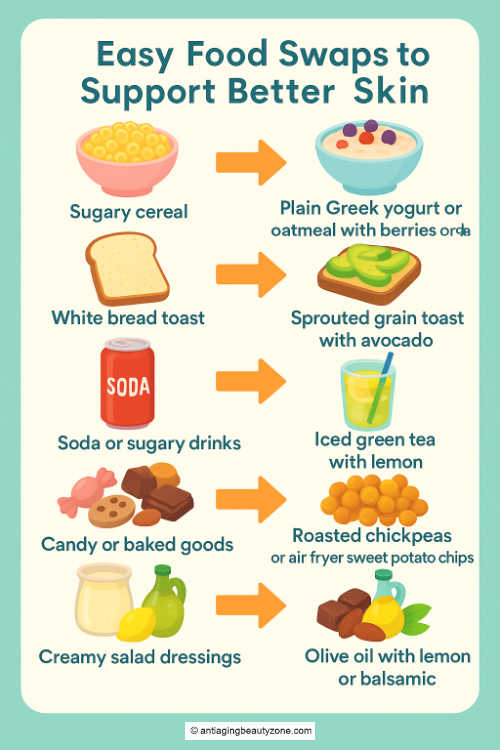
Don’t worry—eating better for your skin doesn’t have to be hard or complicated. It’s really just about making small, doable swaps that support your skin from the inside out.
No rules, no pressure—just a few simple ideas you can try when it works for you.
Here are some of my go-to swaps:
- Sugary cereal → Plain Greek yogurt or oatmeal with berries or chia
- White bread toast → Sprouted grain toast with avocado
- Soda or sugary drinks → Iced green tea with lemon
- Potato chips → Roasted chickpeas or air fryer sweet potato chips.
- Candy or baked goods → A few squares of dark chocolate + almonds
- Creamy salad dressings → Olive oil with lemon or balsamic
- Full pasta bowl → Half pasta, half spaghetti squash (My favorite dinner swap—plus a great time to add that garlic!)
These aren’t rules—just easy ways to work in more nutrients without giving up flavor.
ABZ Tip: If I know I’ll be having pizza or something fun later, I try to stick to skin-friendly foods earlier—like veggies, protein, or healthy fats. It’s not about restriction, it’s about balance. Just giving my skin a little support where I can.
Not perfect—just smarter food swaps for skin health
Feeling overwhelmed? Don’t stress—eating for better skin isn’t about being perfect. Just start adding skin-friendly foods where you can and choosing options that nourish your skin instead of working against it.
A good tip to remember? If something’s ultra-processed or has a super long shelf life, it’s probably not doing much for your skin—and might be better as an occasional treat, not a daily staple.
But that doesn’t mean all packaged foods are off the table.
I still use frozen & canned veggies, canned beans, and jarred tomato paste all the time. They’re budget-friendly, nutrient-dense, and often better than skipping the veggies altogether.
Takeaway: Small food choices, big skin difference
You don’t need a perfect diet for better skin. Just a few smart choices, repeated over time, can go a long way.
Whether it’s tossing spinach into your eggs, adding veggies to your pasta, swapping soda for iced green tea, or adding healthy fats to your plate—it all adds up.
Your skin reflects what’s going on inside. So be kind to it. Nourish it. And don’t stress if you’re not perfect—I don’t aim for perfect either. Just progress.
FAQs
Question: What are the best vitamins for skin?
Question: What are the best vitamins for skin?
Answer: Vitamin C, E, and A (including beta-carotene) are key for skin health. Omega-3s and antioxidants like polyphenols and lycopene also help support collagen and reduce inflammation.
Question: Can food really help reduce wrinkles?
Question: Can food really help reduce wrinkles?
Answer: It can support your skin from within—especially when combined with good skincare habits. Eating nutrient-rich foods won’t erase wrinkles, but it can help skin look firmer, brighter, and more resilient.
Question: Are there any foods that make skin worse?
Question: Are there any foods that make skin worse?
Answer: Ultra-processed foods high in sugar, refined carbs, and unhealthy fats can contribute to inflammation and glycation—both of which can affect skin texture and tone over time.
Question: What’s one easy change to start with?
Question: What’s one easy change to start with?
Answer: Add one “skin meal” a day—just a dish packed with skin-friendly ingredients. Think leafy greens, healthy fats, berries, or colorful veggies.
Question: Is it okay to have sweets or processed foods sometimes?
Question: Is it okay to have sweets or processed foods sometimes?
Answer: Of course. I see it like a bank account—if I know I’ll be splurging later, I try to sneak in a few skin-nourishing foods earlier in the day.
About the Author:
Linda Robison is a Facial Fitness Specialist and the founder of Anti-Aging Beauty Zone. She shares expert insights on skincare, facial rejuvenation, and beauty treatments—blending traditional wisdom, personal experience, and science-backed research for both at-home and in-office solutions.
Before you go ....
Please tap on the💙in the bottom right corner if you found this page helpful.
FOLLOW ME FOR MORE TIPS:
SHARE OR SAVE FOR LATER:

